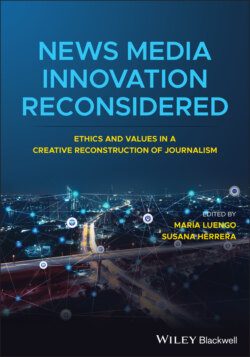Читать книгу News Media Innovation Reconsidered - Группа авторов - Страница 8
Mapping News Innovation Culturally
ОглавлениеA cultural sociology insight into news media innovation allows us to reconsider how the core journalistic values of long-established new media organizations are now being re-signified by new technologies, work processes, and forms of news production and distribution. While the meanings of technologies and practices quickly change, the symbolic codes of journalism remain. Professional values such as “truth,” “accuracy,” “independence,” and “criticism” represent some of the cultural codes of professional journalism, while “falsehood,” “bias,” “inaccuracy,” and “dependence” often describe counter-values of professionalism (Breese and Luengo, 2016). When journalism entered the digital era, the printing press and legacy media had a monopoly over codes of professional journalism, whereas the Internet and new digital media have stood for opposing values. García-Avilés’s Chapter 1 reflects the way in which these values and counter-values of professionalism explain the initial uneasy relationship between ethics and digital technologies in journalism. From 2008, enduring journalistic values have been incorporated into a narrative of “crisis” (see Hermida and Young’s Chapter 3) shared by many practitioners, experts, and scholars (Alexander, Breese, and Luengo, 2016). The crisis narrative associated technologies, forms, and practices of traditional media, particularly printed newspapers, with professional journalism. Many forms, practices, and processes of well-established news organizations around the world had already become potent symbols of professionalism. Traditional media were “signifieds” (meanings) of a broader “signifier”—professional journalism. As Figure I.1 shows, there is an ongoing relationship between signified and signifier. What was signified becomes possible signifier. By combining signifier and signified, many traditional forms of journalism became signs (symbols) of core journalistic and democratic values. Based on this signification, digital technologies have been coded as tangible sites of the threat to the profession.
Figure I.1 The “Crisis in news narrative:” print/legacy media as meanings associated with professional journalism.
Digitalization broke this monopoly power. In the recent context of rapid technological change and economic upheaval, new digital ventures have proliferated, and the pace of change in the signifieds associated with them has accelerated. The continuous work of re-signification progressively places digital technologies on the side of journalistic standards. As Breese and Luengo (2016, p. 284) explain,
When blogs, Twitter, online-only news, live-streaming news, and other technologies enter newsrooms as new avenues for presenting news to the public, they tend to be greeted with anxiety. At first, mainstream journalists distance themselves from the technologies and related practices, dismissing them as antithetical to journalistic standards. Over time what had represented a threat to the news when it was “new” comes to successfully represent the civil codes of professional journalism.
Matthias Revers’s (2016) comparative analysis of how Twitter was adopted by journalists from the official press corps in New York and Bavaria shows the different ways in which digital media encounter specific journalism cultures “which draw from entrenched symbols and sacred discourses of journalism” (Revers, 2016, p. 231). Revers explains how these symbolic codes stand for boundary work that protects the journalistic profession against “competing occupations” as well as “deviant insiders.” He conceives the amalgamation of digital culture and professional journalism as a “cultural performance” (Alexander, 2004), “in which collective representations of professionalism provide the symbolic strength and substantive basis for scripts to act professionally in concrete situations” (Revers, 2016, p. 232).
This boundary process and cultural performance implies a symbolic struggle for newcomers to meet and assert journalistic standards so that they can be considered full players in themselves. New media have produced a discourse seeking to purify past negative characterizations that have positioned them as a threat to journalism. Thus, newly-founded ventures distance themselves from the polluting effects of the market and claims about the financial sustainability of their innovative business models. Once considered the cause of massive layoffs of journalists, falls in advertising revenues, drastic cuts in newsrooms, and other catastrophic consequences in the news business, digital technology is now presented as sustaining journalism. Online news start-ups, for example, have become for many the safety valve of journalism. Born-digital small companies successfully fill market niches of information, reaching where mainstream media cannot. The characterization of news websites, clicks, social networks, or web statistics has shifted from their being seen as sources of aggregative, superficial, sensational, and commodified news to their becoming tools for reporting original stories, breaking news, and conducting in-depth investigative journalism. Figure I.2 conveys this re-signification of the symbolic codes of professional journalism.
Figure I.2 The re-signification of professional journalism through new digital forms.
